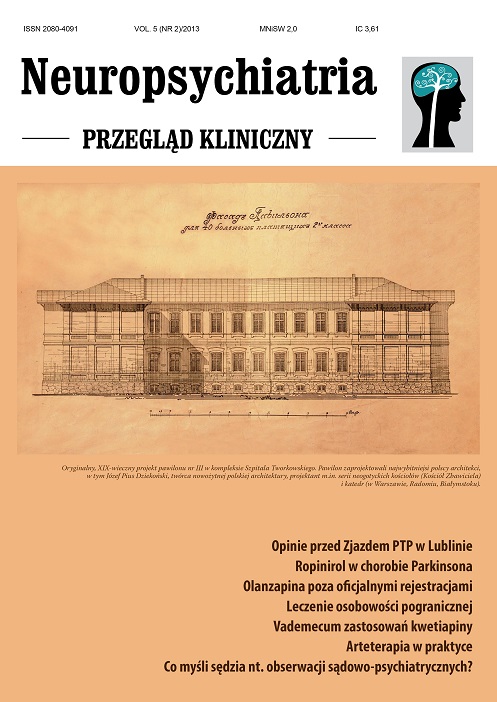Ropinirol – właściwości farmakologiczne i zastosowanie w praktyce klinicznej Artykuł przeglądowy
##plugins.themes.bootstrap3.article.main##
Abstrakt
Ropinirol należy do grupy agonistów receptorów dopaminergicznych, stanowiących obok lewodopy podstawową formę terapii farmakologicznej choroby Parkinsona. Pierwotnie leki te testowano w leczeniu powikłań terapii lewodopą. Jednak wyniki późniejszych badań pokazały, że są one dobrą opcją terapeutyczną również na początku choroby, zarówno w monoterapii, jak i w skojarzeniu z lewodopą. Korzyść ze stosowania agonistów receptorów dopaminergicznych polega na mniejszym ryzyku wczesnych powikłań ruchowych w postaci fluktuacji ruchowych oraz dyskinez. Najczęściej stosowanym lekiem z tej grupy jest w Polsce ropinirol. Wskazania do leczenia obejmują chorobę Parkinsona i zespoły parkinsonowskie, jak również zespół niespokojnych nóg.
##plugins.themes.bootstrap3.article.details##

Utwór dostępny jest na licencji Creative Commons Uznanie autorstwa – Użycie niekomercyjne – Bez utworów zależnych 4.0 Międzynarodowe.
Copyright: © Medical Education sp. z o.o. License allowing third parties to copy and redistribute the material in any medium or format and to remix, transform, and build upon the material, provided the original work is properly cited and states its license.
Address reprint requests to: Medical Education, Marcin Kuźma (marcin.kuzma@mededu.pl)
Bibliografia
2. Kvernmo T, Härtter S, Burger E. A review of the receptor-binding and pharmacokinetic properties of dopamine agonists. Clin Ther 2006; 28(8): 1065-1078.
3. Zesiewicz TA, Hauser RA. Ropinirole in the treatment of Parkinson’s disease. Expert Opin Investig Drugs 1999; 8(5): 697-710.
4. Białecka M. Leczenie choroby Parkinsona, W: Choroba Parkinsona i inne zaburzenia ruchowe. Sławek J, Friedman A, Bogucki A, Opala G (red). Via Medica; Gdańsk 2011.
5. Szczudlik A, Rudzińska M. Neuroprotective effect of dopamine agonists. Neurol Neurochir Pol 2007; 41(2, supl 1): 22s-28s.
6. Brefel C, Thalamas C, Rayet S, Lopez-Gil A, Fitzpatrick K, Bullman= S, Citerone DR, Taylor AC, Montastruc JL, Rascol O. Effect of food on the pharmacokinetics of ropinirole in parkinsonian patients. Br J Clin Pharmacol 1998; 45(4): 412-415.
7. Brooks DJ, Torjanski N, Burn DJ. Ropinirole in the symptomatic treatment of Parkinson’s disease. J Neural Transm Suppl 1995; 45: 231-238.
8. Kulisevsky J, Pagonabarraga J. Tolerability and safety of ropinirole versus other dopamine agonists and levodopa in the treatment of Parkinson’s disease: meta-analysis of randomized controlled trials. Drug Saf 2010; 33(2): 147-161.
9. Nashatizadeh MM, Lyons KE, Pahwa R. A review of ropinirole prolonged release in Parkinson’s disease. Clin Interv Aging 2009; 4: 179-186.
10. Fox SH, Katzenschlager R, Lim SY, Ravina B, Seppi K, Coelho M, Poewe W, Rascol O, Goetz CG, Sampaio C. The Movement Disorder Society Evidence-Based Medicine Review Update: Treatments for the motor symptoms of Parkinson’s disease. Mov Disord 2011; 26(supl 3): S2-41.
11. Aurora RN, Kristo DA, Bista SR, Rowley JA, Zak RS, Casey KR, Lamm CI, Tracy SL, Rosenberg RS. The treatment of restless legs syndrome and periodic limb movement disorder in adults-an update for 2012: practice parameters with an evidence-based systematic review and meta-analyses: an American Academy of Sleep Medicine Clinical Practice Guideline. Sleep 2012; 35(8): 1039-1062.
12. Requip Modutab, Charakterystyka Produktu Leczniczego,2010.
13. Rascol O, Brooks DJ, Brunt ER, Korczyn AD, Poewe WH, Stocchi F. Ropinirole in the treatment of early Parkinson’s disease: a 6-month interim report of a 5-year levodopa-controlled study. 056 Study Group. Mov Disord 1998; 13(1): 39-45.
14. Rascol O, Brooks DJ, Korczyn AD, De Deyn PP, Clarke CE, Lang AE, Abdalla M; 056 Study Group. Development of dyskinesias in a 5-year trial of ropinirole and L-dopa. Mov Disord 2006; 21(11): 1844-1850.
15. Hauser RA, Rascol O, Korczyn AD, Jon Stoessl A, Watts RL, Poewe W, De Deyn PP, Lang AE. Ten-year follow-up of Parkinson’s disease patients randomized to initial therapy with ropinirole or levodopa. Mov Disord 2007; 22(16): 2409-2417.
16. Hersh BP, Earl NL, Hauser RA, Stacy M. Early treatment benefits of ropinirole prolonged release in Parkinson’s disease patients with motor fluctuations. Mov Disord 2010; 25(7): 927-931.
17. Stocchi F, Giorgi L, Hunter B, Schapira AH. PREPARED: Comparison of prolonged and immediate release ropinirole in advanced Parkinson’s disease. Mov Disord. 2011; 26(7): 1259-1265.
18. Pahwa R, Stacy MA, Factor SA, Lyons KE, Stocchi F, Hersh BP, Elmer LW, Truong DD, Earl NL; EASE-PD Adjunct Study Investigators. Ropinirole 24-hour prolonged release: randomized, controlled study in advanced Parkinson disease. Neurology 2007; 68(14): 1108-1115.
19. Reichmann H, Cooper J, Rolfe K, Martinez-Martin P. Sleep Duration and “on” Time during Different Periods of the Day and Night in Patients with Advanced Parkinson’s Disease Receiving Adjunctive Ropinirole Prolonged Release. Parkinsons Dis 2011; 2011: 354760 [online: doi: 10.4061/2011/354760].
20. Allen RP, Earley CJ. Augmentation of the restless legs syndrome with carbidopa/levodopa. Sleep 1996; 19(3): 205-213.
21. Allen RP, Ondo WG, Ball E, Calloway MO, Manjunath R, Higbie RL, Lee MR, Nisbet PA. Restless legs syndrome (RLS) augmentation associated with dopamine agonist and levodopa usage in a community sample. Sleep Med 2011; 12(5): 431-439.
22. Trenkwalder C, Garcia-Borreguero D, Montagna P, Lainey E, de Weerd AW, Tidswell P, Saletu-Zyhlarz G, Telstad W, Ferini-Strambi L; Therapy with Ropiunirole; Efficacy and Tolerability in RLS 1 Study Group. Ropinirole in the treatment of restless legs syndrome: results from the TREAT RLS 1 study, a 12 week, randomised, placebo controlled study in 10 European countries. J Neurol Neurosurg Psychiatry 2004; 75(1): 92-97.
23. Stocchi F, Hersh BP, Scott BL, Nausieda PA, Giorgi L; Ease-PD Monotherapy Study Investigators. Ropinirole 24-hour prolonged release and ropinirole immediate release in early Parkinson’s disease: a randomized, double-blind, non-inferiority crossover study. Curr Med Res Opin 2008; 24(10): 2883-2895.
24. Kelley BJ, Duker AP, Chiu P. Dopamine agonists and pathologic behaviors Parkinson Dis. 2012; 2012: 603631 [online: doi: 10.1155/2012/603631].
25. Santangelo G, Barone P, Trojano L, Vitale C. Pathological gambling in Parkinson’s disease. A comprehensive review. Parkinsonism Relat Disord 2013; 19(7): 645-653.
26. Weintraub D, Koester J, Potenza MN, Siderowf AD, Stacy M, Voon V, Whetteckey J, Wunderlich GR, Lang AE. Impulse control disorders in Parkinson disease: a cross-sectional study of 3090 patients. Arch Neurol 2010; 67(5): 589-595.
27. Weintraub D, Papay K, Siderowf A; Parkinson’s Progression Markers Initiative. Screening for impulse control symptoms in patients with de novo Parkinson disease: a case-control study. Neurology 2013; 80(2): 176-180.

